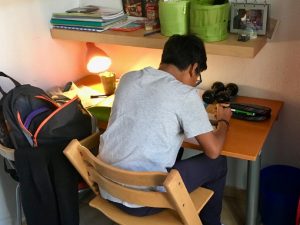
(Brussels) – European Schools, a network of 13 intergovernmental schools primarily teaching children of European Union employees, do not do enough to accommodate the needs of children with disabilities, Human Rights Watch and the European Disability Forum said in a joint report released today.
The 22-page report, “‘Sink or Swim’: Barriers for Children with Disabilities in the European School System,” found that while European Schools are paying increasing attention to inclusion, children with disabilities continued to face problems. They are rejected, pressured into changing schools, or are not provided with appropriate accommodations and support to allow them to learn and thrive in an inclusive environment.
“How can EU institutions claim to promote inclusion and diversity, if the needs of children of their own employees aren’t being met?” said Lea Labaki, of the disability rights division at Human Rights Watch. “At the very heart of the European project, the European School system is not providing children with disabilities the fully inclusive education they are entitled to.”
The European Schools’ Board of Governors’ biannual meeting on December 4-7, 2018, will include a discussion of an internal report on inclusive education and an evaluation of the schools’ educational support policy. The board should develop concrete measures to make European Schools inclusive of children with disabilities.
Human Rights Watch documented the cases of 12 children and one young adult with a range of disabilities who were enrolled in the four European Schools in Brussels and one in Luxembourg or whose enrollment application was refused in the last five years. Human Rights Watch interviewed 27 people, including children, parents, school directors, support coordinators, inclusive education experts, the office of the European Ombudsman, officials of the European Commission’s Directorate-General for Human Resources and Security, and the deputy secretary-general of the European Schools.
“While over the years some improvements have been made, the fate of students with disabilities is still concerning,” said Yannis Vardakastanis, president of the European Disability Forum. “We want the European School system to be a great example for Europe, promoting diversity in all its forms, and ensuring inclusive education to all students with disabilities.”
The EU and its 28 member states have ratified the UN Convention on the Rights of Persons with Disabilities (CRPD), which guarantees children with disabilities the right to inclusive education.
Despite states’ obligations under the convention, European Schools allow excluding children with disabilities. Their Policy on the Provision of Educational Support states that “European Schools do not offer a fully inclusive education system…. [T]he school is entitled to declare itself unable to meet the needs of the pupil.”
Nine parents interviewed reported feeling pressured to remove their child from the school. In some cases, parents said, they experienced harassment, with school officials repeatedly calling them in to complain about their child’s behavior or academic performance.
“Louise,” a 15-year-old girl who has dyslexia, left the European School after struggling for years to get basic accommodations for her learning disability, such as the right to use a device to take pictures of the blackboard. “This school was like an anthill, every year they filtered the best to keep only the elite,” she said. “Those who are a little defective, they do everything they can to reject them. They wanted us to feel bad enough to leave on our own.”
Under the UN convention, children with disabilities have a right to individualized support measures and reasonable accommodations in school, including adapted teaching methods, material and program, assistive technology, and alternative examination formats. Parents said that such accommodations were not systematic and depended on the willingness of school staff.
Further, European Schools offer only one curriculum leading to the European Baccalaureate, which cannot be adapted to children with disabilities’ varying needs, strengths, challenges, and learning styles. In one case, the director told the parents of a boy with learning disabilities that he could move on to secondary school, but that he would never be able to catch up and the school would be “limited to a sort of day care.”
The 13 European Schools in Belgium, Luxembourg, Germany, Spain, the Netherlands, and Italy serve 27,000 children in 20 official EU languages. While there is no data on the number of pupils with disabilities, nearly four percent receive intensive support for “special educational needs,” many of whom have disabilities.
European institutions provide their employees co-funding for the enrollment of children with disabilities in private schools, where fees can be as high as €50,000 a year. The European Commission alone is currently providing such funding to an estimated 70 children for a total budget over €1.5 million, a substantial expenditure of EU funds.
Most parents interviewed said that some teachers and assistants were doing their utmost to help their child and that attitudes were evolving positively.
For these positive experiences to become the norm, the Board of Governors should adopt a policy on inclusive education, develop teacher training, and introduce flexibility in the curriculum, Human Rights Watch and the European Disability Forum said. The European Commission, which provides more than half of the European Schools’ budget, should lead the process and ensure that its funding contributes to an inclusive system.
“Even though European School staff make adjustments, the needs of children with disabilities shouldn’t have to depend on their good will,” Labaki said. “European Schools should make a commitment to inclusive education in policy and practice, and back it up with adequate resources.”
Human Rights Watch.EU: Students with Disabilities Face Barriers at European Schools © 2018 by Human Rights Watch.



